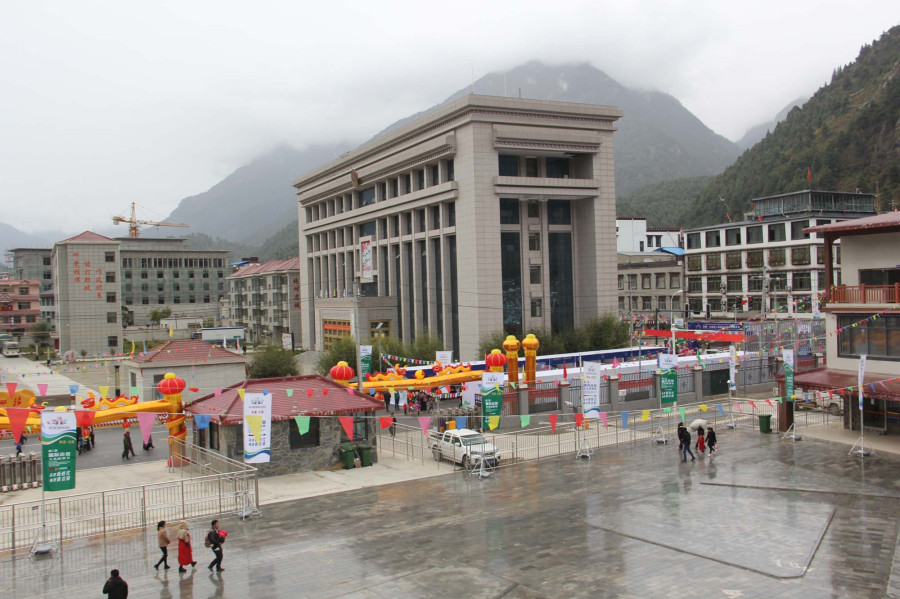Money
Nepali and Chinese officials stress road connectivity to boost tourist arrivals from China
Nepal was able to attract a meagre 0.1 percent out of the total Chinese visiting abroad.
Prahlad Rijal
The proposed Kerung-Kathmandu railway is a distant dream that may be realised in a few decades, but for the near future, road connectivity is essential, a Nepali and Chinese think tank said on Friday.
They said that Nepal-China road connectivity would not only ensure improved Chinese tourist inflow for a certain year, but could be a sustainable way to bring visitors from the northern neighbour.
China remains the world's biggest outbound tourism market with Chinese travellers making nearly 150 million foreign trips in 2018, according to a report by the China Tourism Academy and Ctrip.
Nepal was able to attract a meagre 0.1 percent out of the total outbound despite proximity and improved air connectivity. According to the Tourism Ministry, 153,633 Chinese tourists visited Nepal in 2018, becoming the country's second largest source market. Among the arrivals, more than 26,000 came overland through Rasuwagadhi on the northern border. The government has aimed to bring 350,000 Chinese tourists next year which has been declared Visit Nepal 2020.
Nepal’s tourism industry has also been lobbying to open up restricted regions adjoining the Chinese border.
Zhang Fan, economic chancellor of the Chinese Embassy, said that in the last five years, the countries included in the Belt and Road Initiative witnessed 77 percent growth in the number of Chinese tourists, and the numbers are growing at the rate of 15 percent annually.
Speaking at a workshop entitled ‘Drive tourism initiative and tourism transport safety’ organised by the Belt and Road International Transport Alliance, a think tank for the Belt and Road Initiative founded by the China Highway and Transportation Society on Friday, he said, “There is a need for increased collaboration between Nepal and China on the framework of BRI projects as part of a cross-Himalayan connectivity network.”
Honghua Zhang, deputy director of the International Cooperation Department of China Highway and Transportation Society, said that Nepal’s tourism sector could contribute 10 percent to the country’s gross domestic product if challenges related to tourism infrastructure were resolved.
The comments from Chinese officials have come at a time when Nepal has failed to make headway on infrastructure project negotiations under the Belt and Road Initiative framework which will expire in May 2020.
Nepal and China signed the framework agreement on BRI on May 12, 2017.
Ashish Gajurel, general secretary of the Nepal Automobile Association, said that Chinese officials including representatives of Chinese road construction firms had hinted growing interest in what they called a trans-Himalayan network, particularly road connectivity.
“Although there is scope of bringing in Chinese tourists or enhancing trade through road networks, the government has not taken the initiative to finalise such projects as part of the Belt and Road Initiative,” said Gajurel.
“There are investment opportunities in Nepal’s transport and tourism sector, and if we could bring direct investments to build roads on the northern border, we can host Chinese tourists in greater numbers.”
Most villages in Taplejung, Sankhuwasabha, Solukhumbu, Dolakha, Rasuwa, Gorkha, Mustang, Manang, Dolpa, Mugu and Humla districts that share a border with China were declared out of bounds to foreign visitors in the 1970s.
Foreigners are required to get special permits from the Department of Immigration to travel to these areas. Also, permits are not given to individual trekkers. Only trekkers travelling in a group through a government authorised trekking agency can apply for permission. Permit fees range from $10 per week to $500 for 10 days depending on where you go.
Trekking agencies and tour operators have been lobbying with the government to open up such areas that have an immense potential to contribute to the country’s tourism and the local economy.
In the 1970s, the government imposed restrictions on the movement of foreigners in a number of northern villages bordering China's Tibet region as Khampa rebels were found using Nepali territory to mount cross-border raids. In 1974, the Nepal Army succeeded in completely disarming the Khampa rebels, but the travel restrictions remained.
Nepal’s travel entrepreneurs say that lack of government initiative to open up northern border regions and develop proper road connectivity has hindered growth prospects.
“Chinese visitors opting to travel to Lo Manthang have to fly to Kathmandu first and take the bus from here which makes their travel costlier when compared to travelling to their destination by bus via the Korala border point,” said Govinda Bhattarai, the chairperson of Mountain Sports Federation Nepal, which is associated with the Alliance.
“We are constantly lobbying to promote drive tourism as a product based on-road travel offering trans-Himalayan tours, but issues of road connectivity, safety and legal restrictions have put a dent in the plan.”
Chinese stakeholders and lobbyists pushing for building high-quality roads linking Nepal and China have hinted at the prospects of the much-hyped cross-border railway frittering away.
Chinese officials have time and again referred to the Kerung-Kathmandu railway as a ‘long-term project’ which entails overcoming immense geographical complexities.
According to the International Road Assessment Programme, ensuring more than 75 percent of travel is on the equivalent of three-star or better roads for all road users by 2030 will be critical for Nepal to achieve the Sustainable Development Goals, and the BRI can make important contributions to the targets.
“In Nepal, achieving greater than 75 percent of travel on three-star or better roads for all road users by 2030 stands to save over 2,000 lives each year with an economic benefit to the country of over $6 billion,” said the International Road Assessment Programme.




 6.73°C Kathmandu
6.73°C Kathmandu















